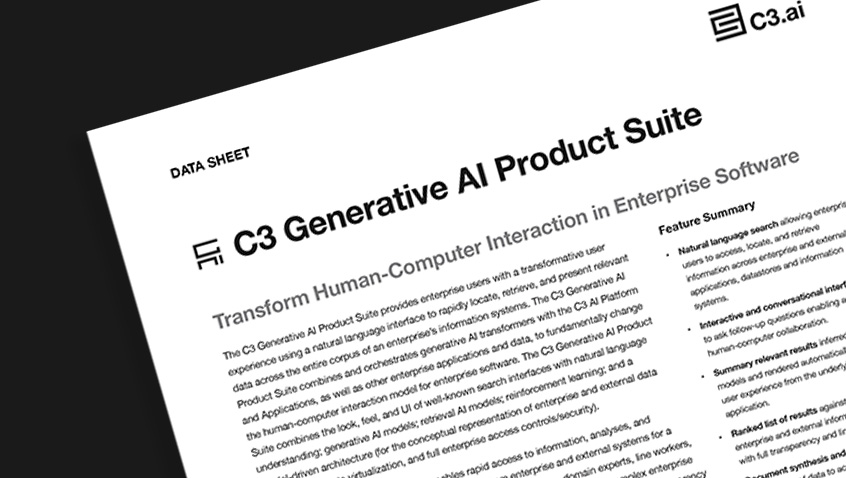- AI Software
- C3 AI Applications
- C3 AI Applications Overview
- C3 AI Anti-Money Laundering
- C3 AI Cash Management
- C3 AI Contested Logistics
- C3 AI CRM
- C3 AI Decision Advantage
- C3 AI Demand Forecasting
- C3 AI Energy Management
- C3 AI ESG
- C3 AI Health
- C3 AI Intelligence Analysis
- C3 AI Inventory Optimization
- C3 AI Process Optimization
- C3 AI Production Schedule Optimization
- C3 AI Property Appraisal
- C3 AI Readiness
- C3 AI Reliability
- C3 AI Smart Lending
- C3 AI Supply Network Risk
- C3 AI Turnaround Optimization
- C3 Generative AI Constituent Services
- C3 Law Enforcement
- C3 Agentic AI Platform
- C3 Generative AI
- Get Started with a C3 AI Pilot
- Industries
- Customers
- Events
- Resources
- Generative AI for Business
- Generative AI for Business
- C3 Generative AI: How Is It Unique?
- Reimagining the Enterprise with AI
- What To Consider When Using Generative AI
- Why Generative AI Is ‘Like the Internet Circa 1996’
- Can the Generative AI Hallucination Problem be Overcome?
- Transforming Healthcare Operations with Generative AI
- Data Avalanche to Strategic Advantage: Generative AI in Supply Chains
- Supply Chains for a Dangerous World: ‘Flexible, Resilient, Powered by AI’
- LLMs Pose Major Security Risks, Serving As ‘Attack Vectors’
- What Is Enterprise AI?
- Machine Learning
- Introduction
- What is Machine Learning?
- Tuning a Machine Learning Model
- Evaluating Model Performance
- Runtimes and Compute Requirements
- Selecting the Right AI/ML Problems
- Best Practices in Prototyping
- Best Practices in Ongoing Operations
- Building a Strong Team
- About the Author
- References
- Download eBook
- All Resources
- Publications
- Customer Viewpoints
- Blog
- Glossary
- Developer Portal
- Generative AI for Business
- News
- Company
- Contact Us
- Generative AI for Business
- Reimagining the Enterprise with AI
- What To Consider When Using Generative AI
- Why Generative AI Is ‘Like the Internet Circa 1996’
- Can the Generative AI Hallucination Problem be Overcome?
- Transforming Healthcare Operations with Generative AI
- Data Avalanche to Strategic Advantage: Generative AI in Supply Chains
- Supply Chains for a Dangerous World: ‘Flexible, Resilient, Powered by AI’
- LLMs Pose Major Security Risks, Serving As ‘Attack Vectors’
- C3 Generative AI: Getting the Most Out of Enterprise Data
- The Key to Generative AI Adoption: ‘Trusted, Reliable, Safe Answers’
- Generative AI in Healthcare: The Opportunity for Medical Device Manufacturers
- Generative AI in Healthcare: The End of Administrative Burdens for Workers
- Generative AI for the Department of Defense: The Power of Instant Insights
- C3 AI’s Generative AI Journey
- What Makes C3 Generative AI Unique
- How C3 Generative AI Is Transforming Businesses
Generative AI and the Future of Business

The Significance of Domain Models for Enterprises
A significant breakthrough in generative AI came with the development of transformer models—neural networks that can learn the context of sequential data—to rapidly create high quality, comprehensive responses to user queries. Transformer models were first described in an important Google research paper in 2017 called “Attention Is All You Need,” and they have been advancing ever since.
The capabilities of generative AI have both amazed and scared the public, some of which detracts from the opportunity for businesses with generative AI. Because the current versions of popular generative AI models, such as Chat GPT and Google Bard, have been trained on a wide body of publicly available data, they lack the nuances required for specific domains, which is where domain models come in.
For a manufacturer or health care service to take advantage of generative AI, they need a system that generates content—reports, analysis, etc. — based on data relevant to their domains, including such data sets as terms specific to a company. Most of an enterprise’s specific data is proprietary, sensitive, and sits behind a firewall. As such, applying generative AI to the enterprise requires domain models.
Domain models combine the fluency and comprehensibility of emerging transformers with the domain-specific data and knowledge of an enterprise. With access to the corpus of data, best practices, and policies specific to an enterprise, generative AI models can, for example, answer inventory-related search queries for supply chain analysts, create brand-compliant graphics for marketing managers, and identify potential compliance exceptions in new contracts.
Domain models will generate the greatest value for enterprises by finding contextually relevant and policy-compliant responses to user queries. Sophisticated domain models have the greatest value potential for enterprises by not just tapping into existing enterprise data, but by calculating metrics and analyzing that data to produce value-added content for enterprise users.
Supply chain executives trying to identify how well their company is fulfilling customer orders will be less interested in looking at each order’s fulfillment history. Rather, they’d want to see On-Time-In-Full (OTIF) history by product line, customer, or region. The ability of domain models not just to find and regurgitate data, but to combine data and create business-relevant metrics analysis that are predictive in nature is where generative AI models can become invaluable to enterprise users.
Domain models also build upon existing analytical frameworks and business logic to find correlations between data, identifying cause-and-effect and generating analytic-backed insights. In the above example of a supply chain executive investigating service levels, domain models will not just produce an OTIF report, but also an analysis of potential drivers of poor OTIF, caused perhaps by a specific transportation provider or linked to the timing of orders relative to the planning cycle of the company.
Domain models will be able to support enterprise users not just in analyzing the past but in taking proactive actions by using predictive insights. The supply chain executive in the above scenario will be supported by their domain generative model by identifying the future orders with the highest risk of delays along with explanations of the drivers of each order’s risks.
Enterprises leveraging domain generative models will capture outsized value not just by effortlessly generating insights for their users, but by also giving them the ability to act on those insights. By integrating generative AI capabilities with personal productivity tools and enterprise applications, companies will give their users the ability to:
- Take personal actions such as generating reports or setting alerts
- Initiate collaborative actions by kicking off a new project or create the agenda of a group meeting
- Kickoff workflows in enterprise applications such as accelerating supply orders, creating support tickets, or generating a customer discount.
Let’s get back to our supply chain executive investigating customer delivery fulfillment. Using domain generative models, the executive can identify past track records and risks to future deliveries, as well as making changes to production schedules and transportation arrangements to expedite critical orders at risk of delay.



